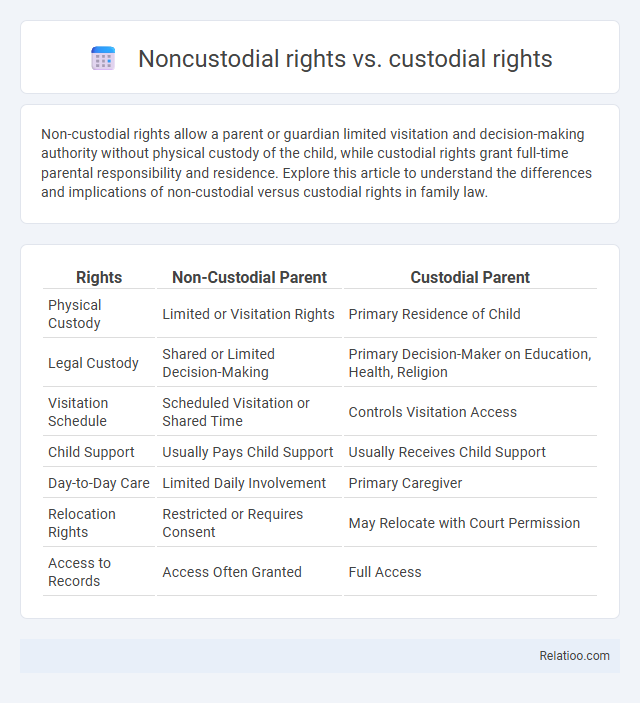Non-custodial rights allow a parent or guardian limited visitation and decision-making authority without physical custody of the child, while custodial rights grant full-time parental responsibility and residence. Explore this article to understand the differences and implications of non-custodial versus custodial rights in family law.
Table of Comparison
| Rights | Non-Custodial Parent | Custodial Parent |
|---|---|---|
| Physical Custody | Limited or Visitation Rights | Primary Residence of Child |
| Legal Custody | Shared or Limited Decision-Making | Primary Decision-Maker on Education, Health, Religion |
| Visitation Schedule | Scheduled Visitation or Shared Time | Controls Visitation Access |
| Child Support | Usually Pays Child Support | Usually Receives Child Support |
| Day-to-Day Care | Limited Daily Involvement | Primary Caregiver |
| Relocation Rights | Restricted or Requires Consent | May Relocate with Court Permission |
| Access to Records | Access Often Granted | Full Access |
Understanding Custodial and Non-Custodial Rights
Custodial rights grant a parent or guardian legal authority and responsibility over a child's care, including making decisions about education, health, and welfare. Non-custodial rights typically involve visitation or limited decision-making without primary caregiving duties, ensuring ongoing parental involvement without residential responsibility. Understanding the distinction between custodial and non-custodial rights is crucial for legal clarity in child custody arrangements and parental responsibilities.
Key Legal Definitions Explained
Non-custodial rights refer to a parent's legal ability to make important decisions about a child's welfare without having physical custody, while custodial rights grant a parent primary physical custody and daily care responsibilities. Custodial rights often include living arrangements, education, and healthcare decisions, whereas non-custodial rights may involve visitation schedules and participation in major decisions. Understanding these distinctions is crucial for navigating family law, as courts prioritize the child's best interests in assigning and enforcing these rights.
Primary Differences Between Custodial and Non-Custodial Rights
Custodial rights grant a parent or guardian legal authority to make decisions regarding a child's welfare, education, and healthcare, often involving physical custody or guardianship. Non-custodial rights typically refer to visitation or parenting time without decision-making power or day-to-day care responsibilities. The primary differences center on decision-making authority and physical custody, where custodial parents hold comprehensive control, while non-custodial parents have limited access focused on maintaining contact.
Decision-Making Authority: Who Holds the Power?
Decision-making authority in child custody cases distinguishes non-custodial rights, custodial rights, and non-custodial arrangements by defining who holds the power to make significant decisions about the child's education, healthcare, and welfare. Custodial rights grant the parent primary control over daily care and decision-making, whereas non-custodial rights typically limit decision-making authority to visitation and support responsibilities without major control over the child's life. Shared decision-making may occur in joint custody scenarios where both parents retain legal rights to influence critical choices affecting the child's upbringing.
Impact on Child’s Daily Life and Routine
Custodial rights grant primary decision-making power and physical custody, directly shaping the child's daily routine, education, healthcare, and extracurricular activities. Non-custodial rights typically involve visitation and limited decision-making, resulting in less influence over the child's immediate environment and daily schedule. Non-custodial arrangements can create divided routines but often encourage flexibility and additional emotional support from both parents.
Visitation Rights for Non-Custodial Parents
Non-custodial parents hold visitation rights that allow them scheduled time with their children despite not having primary physical custody. Custodial parents maintain primary decision-making authority and daily care responsibilities, while non-custodial parents exercise visitation rights that promote ongoing relationships and involvement. Visitation rights may include weekends, holidays, and special occasions, ensuring non-custodial parents remain active figures in their children's lives.
Child Support Obligations and Financial Responsibilities
Non-custodial rights pertain to a parent's legal ability to spend time with their child without holding primary custody, but they are still obligated to fulfill child support payments and shared financial responsibilities. Custodial rights grant a parent primary custody, making them primarily responsible for the child's daily care while typically receiving child support from the non-custodial parent. You must understand that non-custodial status does not exempt you from financial obligations, ensuring the child's needs are met regardless of custody arrangements.
Modifying Custodial and Non-Custodial Arrangements
Modifying custodial and non-custodial arrangements involves legal processes that can alter the custody or visitation terms established in court orders. You must file a petition with the family court to request changes based on significant changes in circumstances affecting the child's welfare. Custodial rights grant physical and legal custody, while non-custodial rights typically involve visitation and decision-making input without primary custody, making modifications critical for adapting to evolving family dynamics.
Benefits and Challenges of Each Custody Type
Non-custodial rights grant parents visitation and decision-making authority without physical custody, providing benefits such as maintaining parental involvement and reducing conflict, yet pose challenges like limited daily influence and potential scheduling disputes. Custodial rights confer physical custody and responsibility for the child's daily needs, offering stability and consistent care but can lead to increased stress and financial burdens for the custodial parent. Non-custodial arrangements facilitate flexible parenting roles and shared responsibilities but may face challenges regarding enforcement of visitation and ensuring equitable participation in major decisions.
Protecting the Best Interests of the Child
Non-custodial rights refer to the legal permissions granted to a parent who does not have primary physical custody, allowing them visitation or involvement in major decisions affecting the child's welfare. Custodial rights involve the parent with whom the child primarily resides, giving them authority over daily care and important choices like education and healthcare. Your focus should always be on protecting the best interests of the child by ensuring that both custodial and non-custodial parents cooperate to provide emotional stability and meet the child's physical and psychological needs.

Infographic: Non-custodial rights vs Custodial rights
 relatioo.com
relatioo.com